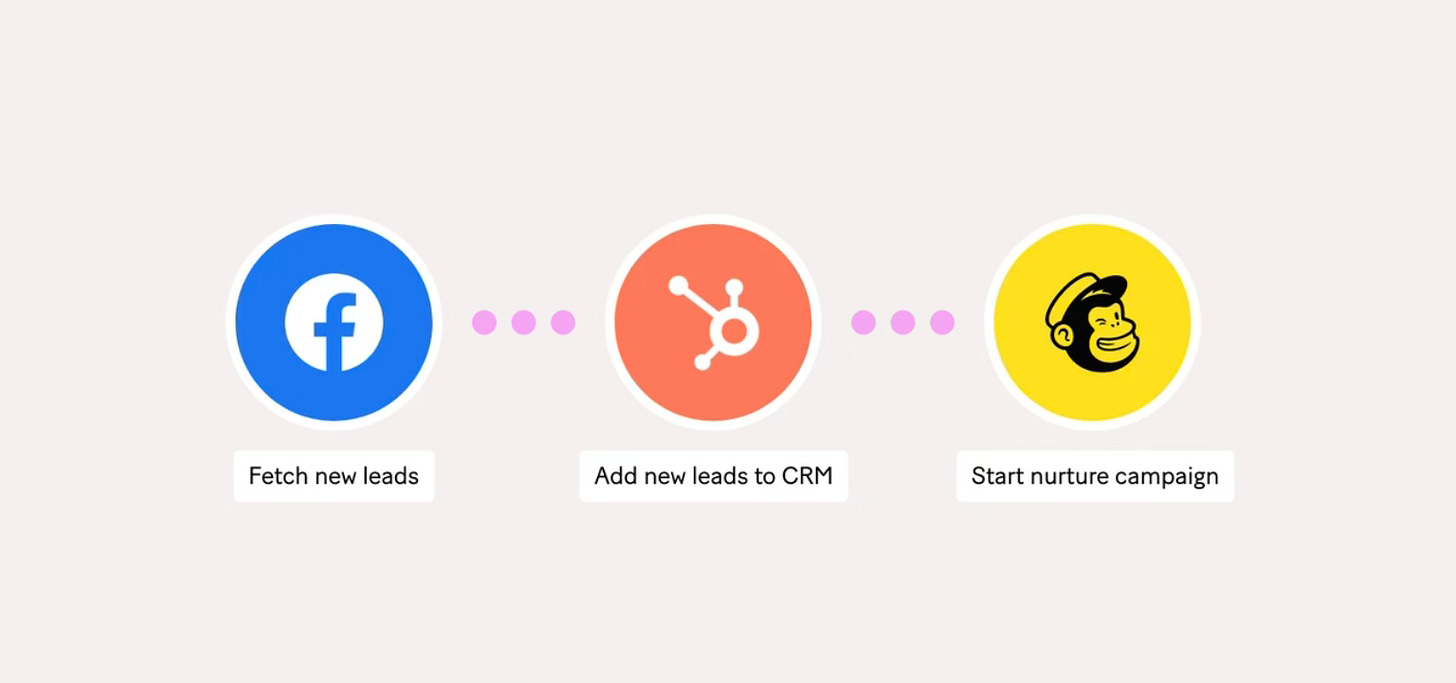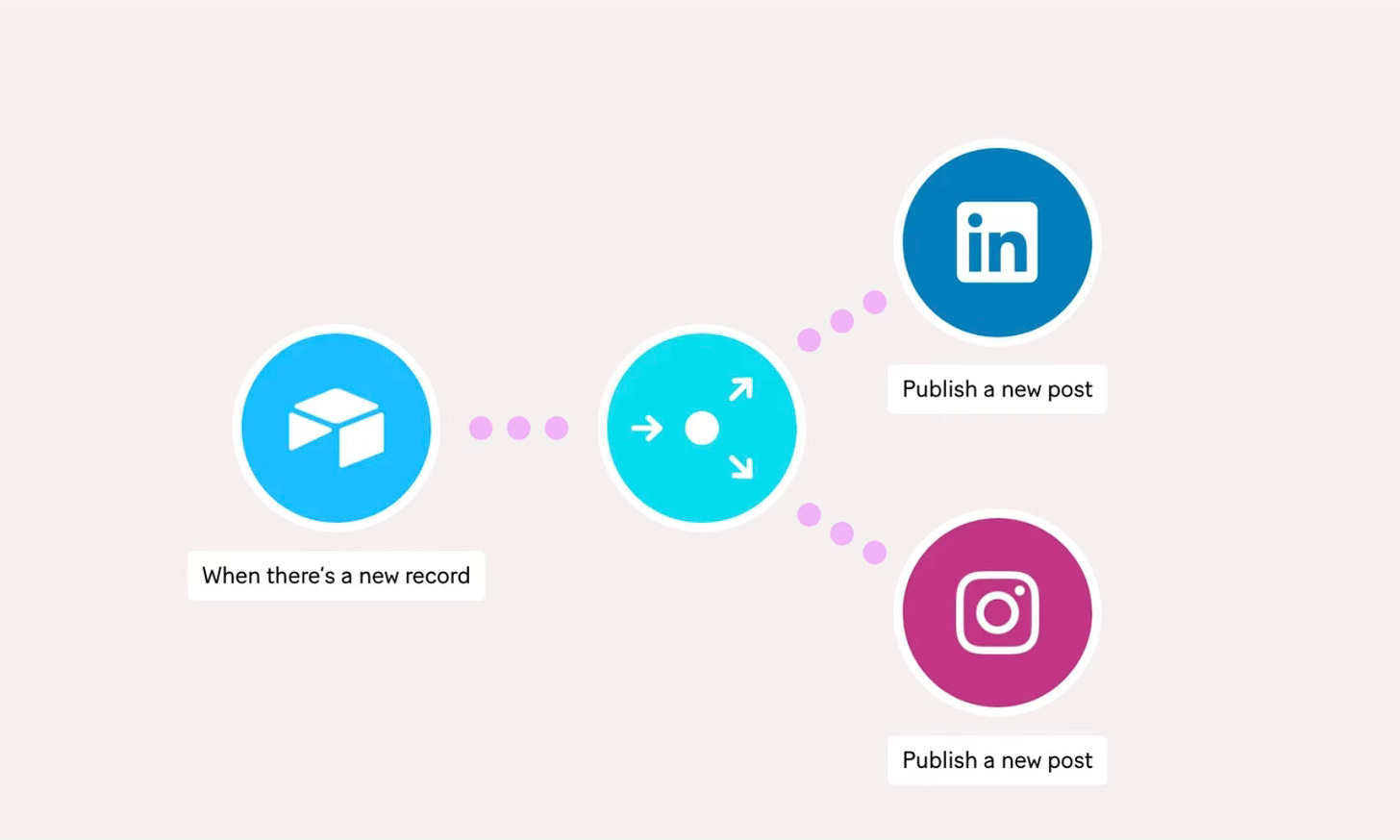4 Ways of SaaS integrations: Workflow Automation (part 2/4)
In this series with tool integrations I will detail the four ways of tool integrations (Direct integrations, Third-party aggregators, User Interface Automation/RPA, Custom development using APIs).
Happy automation Friday!
In the previous post, I talked about the various ways of integrating applications. There are four ways to integrate tools:
By the end of this article, it should be clearer when to use a direct integration or a third-party app. Additionally, you will know how to approach a custom solution for integration and how to choose the right use cases for user interface automation.
Third-party aggregators
This is one of the most common methods used by those who want to explore automation. In recent years, there have been a bunch of tools built to help you manage those integrations. The most common ones are Make.com (previously named Integromat), Zapier, and IFTTT (I find it very useful for personal use, such as home automation or tasks for self-management).
Differences
Compared to direct integration, these aggregators are somewhat different. There are two major differences between them:
Flow-oriented design: This allows you to connect multiple apps and create a flow, instead of just a one-way/two-way connection between two apps.
Third-party development: This allows various developers (or even you, for some of them) to develop your own modules/connectors for your apps, which greatly expands the capability of these infrastructures.
How it works
You need to provide credentials for each of the apps you are using, to be able to connect them in the future to any flow.
Each of the apps has its own "actions" available, which expand your possibilities. For example, in make.com, for Google Sheets, there are more than 25 actions available, such as "Create a row", "Delete a row", and "Empty a row".
The connected apps send the information or parameters through these aggregators, which perform the automation itself. For example, you can send data from your Stripe account (data such as customer name, order ID, order value, and order currency) to your Xero / billing provider (to automatically generate an invoice based on this data).
The aggregators offer you some default functions to manage each connector’s parameters and filter through them. This is the main difference from direct integration. You can use these functions for all of the connectors in your flow. In contrast, with direct integration, each platform might offer you some of those functions or not. Based on the previous example, using those default functions, you can transform the Stripe date field into a new format, send only the confirmed orders, and filter by specific country.
Advantages
Enables you to create complex integrations between multiple solutions.
Simpler to manage multiple integrations than the direct option, especially if you have a wiki page where you explain the purpose of each scenario, the applications used, and the exceptions.
You can build your own applications or you can manually integrate any API, which extends your integration capabilities.
Easy to handle errors; most of them have their error handlers, logs, and queue logs where you can restart an incomplete scenario. This is a very important factor for scenarios without fallbacks.
Disadvantages
Most of them have an extra cost; the free plans are very limited.
Some of them are developer-oriented (like Make.com), and even the most user-oriented ones (like Zapier) have a technical component that can't be avoided if you want to do complex things.
Things could go wrong easily if the scenarios are not developed correctly.
Use Cases
Example 1
As an agency, I want to generate contracts, agreements, and invoices for new customers, so that I can increase customer satisfaction by reducing errors, reducing waiting time, and removing the workload from the financial team.
Why use third-party integration?
The process has some exceptions. In our case, I want to run this process only for new customers, so the entire process should be connected to a CRM to filter between new and existing customers.
The process involves connecting various tools, for example:
Airtable for CRM, where you manage all the generated contracts, the signature status, the duration of the contract, client personal details, etc.
DocuSign for contract generation and signatures
Xero for invoices and payment methods
When can’t you use third-party integration?
When the data for contract generation is not normalized in different fields (Company, VAT Number, Address, etc.). For example, if you are working in face-to-face sales and that data is hand-written.
When you want to have some non-predictable variations in contract conditions and can’t use a template.
When you prefer a different way of communication with the client that is not predictable. For example, for some clients, you prefer to use a paper contract, for others, you prefer to use the default email generated by DocuSign, for others you prefer to send it manually via email, and for others to send it on WhatsApp / Facebook Messenger. Even if it’s possible to create some automation like this, the whole process would become difficult to manage.
How could this process evolve?
I recommend using third-party automation in all cases, even if it is easier to do it directly. The main reason is that the process could and should evolve; even if it doesn’t seem like this at the beginning.
For example, in our case, the process could have some extra requirements:
Send a new reminder in X days if the contracts are not signed.
Send a thank you message when the invoice is paid (if Xero doesn’t offer this functionality).
Send the data from the contracts to your cash flow app.
Mark some sales deals as “Win” when a new contract is signed.
Calculate commissions for your sales team for each new contract signed.
Your company requirements could be endless. The easiest way is to prepare the infrastructure for this from the beginning after you are sure that the process is useful for the organization (after the MVP phase).
Example 2
As a business coach, I want to allow my customers to check my availability, book their sessions, and keep the notes together so I can increase customer retention by reducing the friction from booking and providing value in follow-up emails.
Why you could use third-party integration?
The process isn’t straightforward. Each customer could have a unique price (defined in Airtable), they could have sessions included in the subscription, and each extra session could be a different price. The community ranks could depend on the number of coaching sessions they’ve had or the cohort.
The process involves connecting various tools, for example:
Airtable as a CRM, where you manage all the clients and all the bookings.
Calendly for booking management and calendar availability.
Google Docs for note-taking during the coaching sessions.
Gmail for custom follow-up emails.
Xero for invoicing and payments.
Mailchimp for community communication.
When can’t you use third-party integration?
When you want to have some non-predictable variations in the process, such as ad-hoc meetings or real-time unique prices for each customer.
When you want to extract some information from a different source for note-taking (such as WhatsApp messages or paper information).
How could this process evolve?
I recommend using third-party automation in all cases, even if it is easier to do it directly. The main reason is that the process could and should evolve; even if it doesn’t seem like this at the beginning.
For example, in our case, the process could have some extra requirements:
Give an extra session bonus after every 10 coaching sessions.
Subscribe customers to a WhatsApp group once they become premium customers.
Confirm the meetings via SMS within 24 hours before the meeting.



